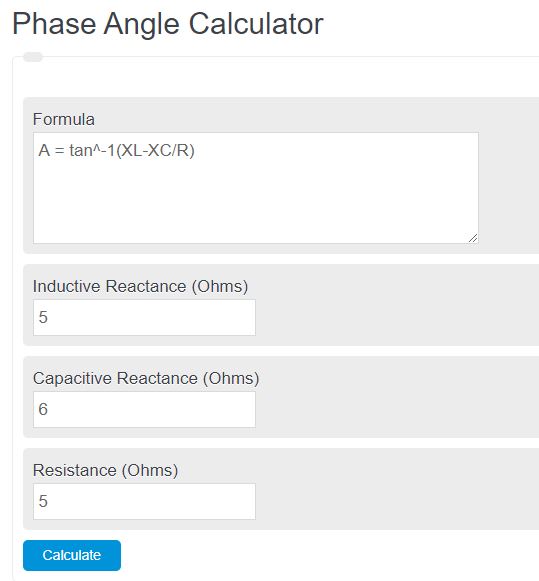Enter the inductive reactance, capacitive reactance, and resistance. The calculate will evaluate and display the phase angle in degrees or radians.
- Capacitive Reactance Calculator
- Inductor Energy Storage Calculator
- Transformer Calculator
- Phase Difference Calculator
- Reactive Power Calculator
- 3 Phase Motor Efficiency Calculator
Phase Angle Formula
The following equation can be used to calculate the phase angle of a coil.
A = atan(XL-XC/R)
- Where A is the phase angle
- XL is the inductive reactance
- XC is the capacitive reactance
- R is the resistance
To calculate a phase angle, take the inverse tangent value of the value of the inductive reactance minus the capacitive reactance divide by the resistance.
Phase Angle Definition
A phase angle is an amount at which the voltage of a coil or circuit is leading or lagging behind the current of the same coil or circuit. This term is used most in electromagnetism.
Phase Angle Example
How to calculate a phase angle?
The following example problem outlines the necessary steps in calculating the phase angle of an electrical coil or circuit.
The first step is to determine the inductive reactance through measurement or calculation.
For this example, the inductive reactance is found to be 50 ohms.
Next, determine the capacity reactance of the same circuit or coil.
In this case, the capacity reactance is found to be 25 ohms.
Next, determine the total resistance of the circuit.
For this problem, the total resistance is 10 ohms.
Finally, calculate the phase angle using the formula above:
A = tan^-1(XL-XC/R)
A = tan^-1(50-25/10)
A = 88.79 degrees.
FAQ
A phase angle is the leading or lagging amount that the voltage is moving through a circuit.

